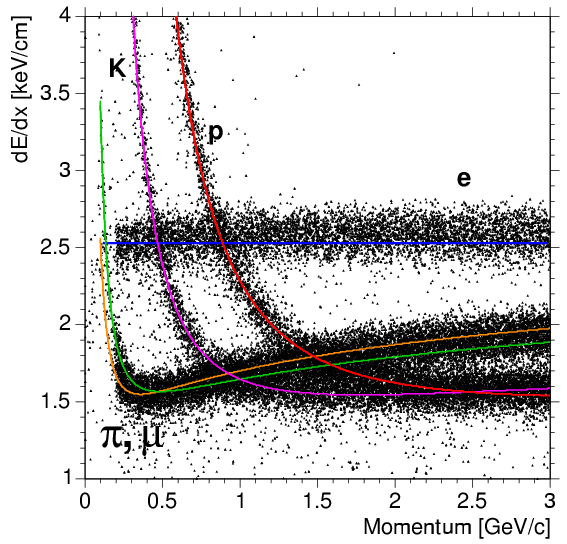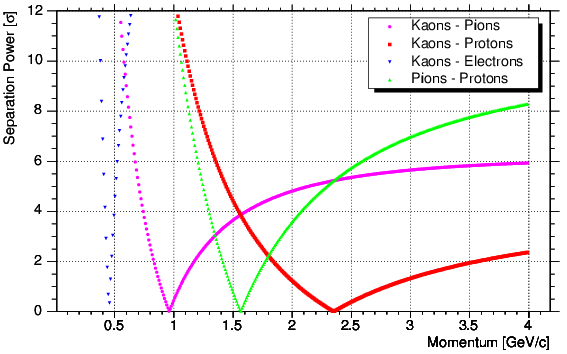You are here: Panda Wiki>Tagpid Web>TasksandResults>TpC (2006-05-19, QuirinWeitzel)Edit Attach
Purpose
Tracking: The TPC is discussed as a solution for the outer tracking within the target spectrometer. The required momentum resolution is ~1%, the required vertex resolution ~150um in the xy plane and < 1cm in z direction. PID: In the momentum range below ~1GeV and above ~2GeV the TPC provides information for particle identification within the target spectrometer. Especially for particles with momenta below ~1GeV this is of great help for the overall PID performance and to supplement the information from the barrel DIRC.Working principle (in short)
General: 3D tracking device - charged particles ionize detector gas - electric field along cylinder axis separates positive gas ions from electrons - primary electrons drift towards readout anode - gas amplification done by several GEM foils - ungated, continuous operation mode due to HESR beam properties - intrinsic ion feedback suppression by GEM foils - continuous data readout within PANDA DAQ - parallel online data reduction and processing (including tracking) PID: performed via measurement of mean energy loss per track length (dE/dx), described by Bethe-Bloch-formula, in combination with (obligatory) momentum measurement - PANDA TPC offers to do ~50-100 (fluctuating) energy loss measurements per track - truncated mean algorithm used to get rid off Landau tail and to calculate mean

Important values
Geometry: inner radius: 15cm, outer radius: 42cm, length: 150cm, gas volume: 700l, 2 separate chambers (due to target pipe) Material budget: ~1.5% X/X0 Detector gas: Ne/CO2 (90/10, maybe admixture of CH4), gas gain: several 1000 Operation: drift field: 400V/cm, 2x2mm pads (100000)First estimates and simulations (obtained from old PANDA framework and preliminary)
Data were generated based on an event generator which shoots p, K, pi, mu and e (plus antiparticles) isotropically through the TPC. All tracks come from the IP, with momenta between 0.2 and 4GeV/c. Tracks are divided into 6mm pieces, for each the energy loss is calculated resulting in 50-100 measurements depending on track length. Upper 40% are discarded and mean dE/dx calculated (truncated mean). The spread of the these dE/dx values for certain p bins is fitted with a Gaussian and the dE/dx resolution is defined as the corresponding sigma.

The separation power between two particles is defined as: 2*|I1 - I2| / (sigmaI1/I1 + sigmaI2/I2), where I stands for the dE/dx of the respective particle. A constant dE/dx resolution of 5% was assumed.

Note: For all the simulation results shown here the gas density value was a factor of 1.5 to high. Therefore we expect the performance to be a bit worse. For example the dE/dx resolution will change from ~5% to ~7%. Simulations will be repeated with the new PANDA framework as soon as possible.
-- QuirinWeitzel - 10 May 2006
| I | Attachment | Action | Size | Date | Who | Comment |
|---|---|---|---|---|---|---|
| |
PIDoverview.png | manage | 132 K | 2006-05-18 - 18:15 | UnknownUser | dE/dX curves for PANDA TPC |
| |
SeparationPower.png | manage | 29 K | 2006-05-19 - 09:50 | UnknownUser | Separation Power of PANDA TPC |
| |
TPC_Geom.png | manage | 318 K | 2006-05-15 - 17:14 | UnknownUser | TPC geometry from simulation |
| |
dEdxResolution.png | manage | 20 K | 2006-05-19 - 09:49 | UnknownUser | dE/dE Resolution for PANDA TPC |
| |
tpc-gem_principle.png | manage | 35 K | 2006-05-15 - 16:44 | UnknownUser | GEM-TPC working principle |
Edit | Attach | Print version | History: r6 < r5 < r4 < r3 | Backlinks | View wiki text | Edit wiki text | More topic actions
Topic revision: r6 - 2006-05-19, QuirinWeitzel
Tagpid Web
Web Home | Search Changes | Notifications Index | Topics
Web Home | Search Changes | Notifications Index | Topics
- Webs
- Cerenkov * Cerenkov.Pandacerenkov * DCS * Daq * Daq.Pandadaq * Detector * EMC * EMPAnalysis * Forwardstraws * GEM * MC * Magnet * Main * Mvd * PANDAMainz * PWA * Pbook * Personalpages * Physics * Physics.Baryons * Physics.CharmoniumAndExotics * Physics.HadronsInNuclei * Physics.OpenCharm * PhysicsCmt * SPC * STT * Sandbox * ScrutinyGroup * Tagpid * Tagpid.Pandatagpid * Tagtrk * Tagtrk.Pandatagtrk * Target * Target.ClusterJetTarget * Tof * WebServices * YoungScientists * ZArchives
Create personal sidebar
Copyright © by the contributing authors. All material on this collaboration platform is the property of the contributing authors.
Ideas, requests, problems regarding Panda Wiki Send feedback | Imprint | Privacy Policy (in German)
Ideas, requests, problems regarding Panda Wiki Send feedback | Imprint | Privacy Policy (in German)


